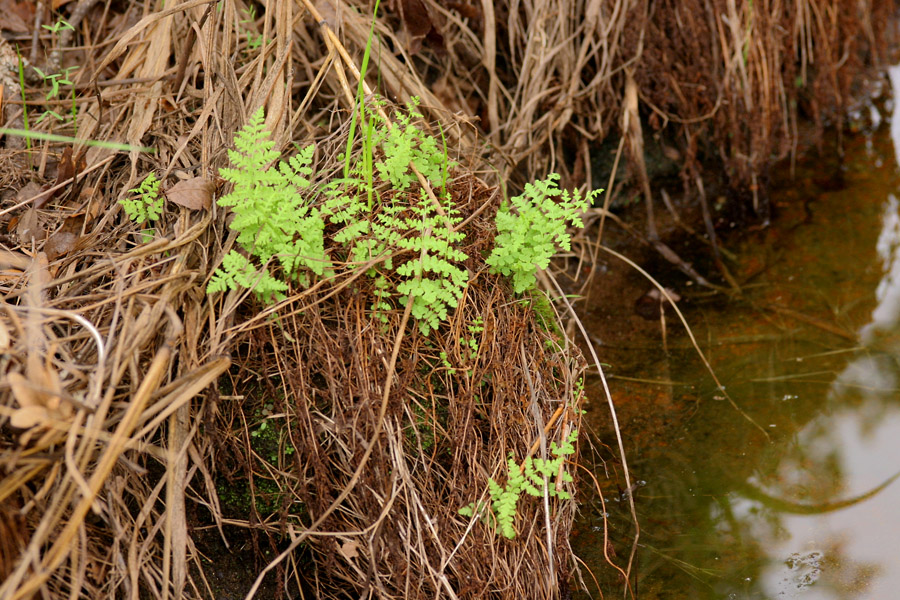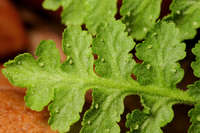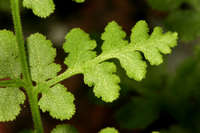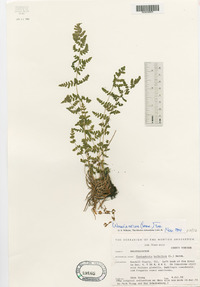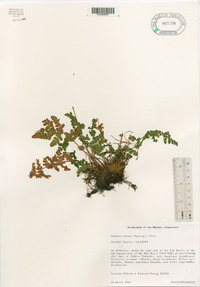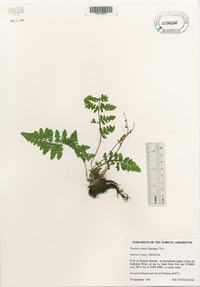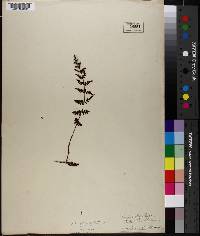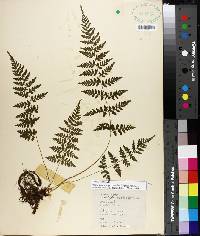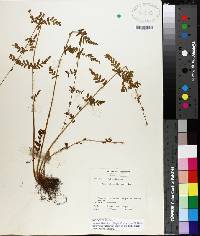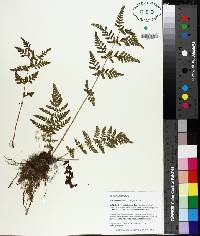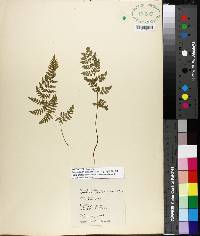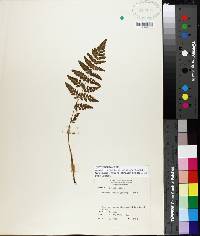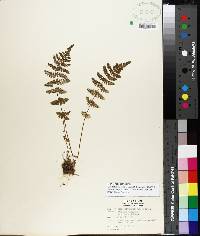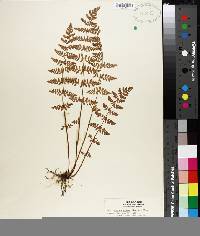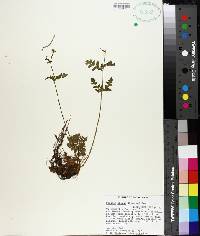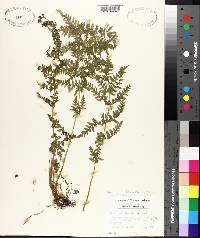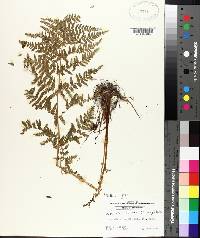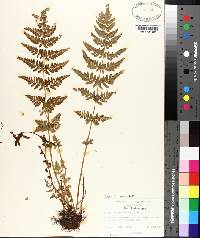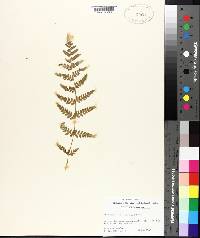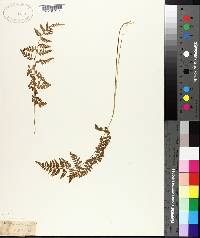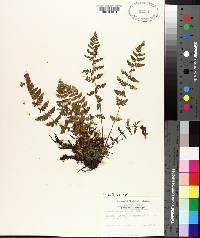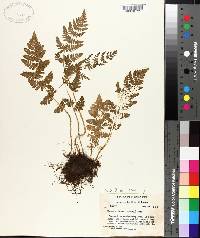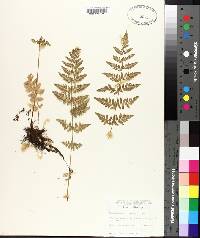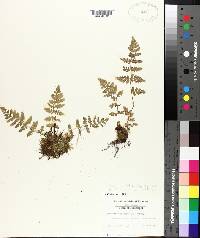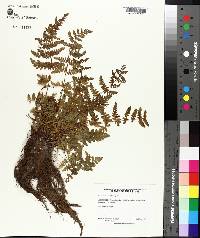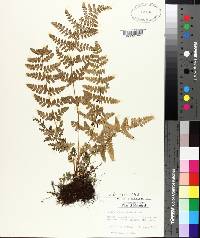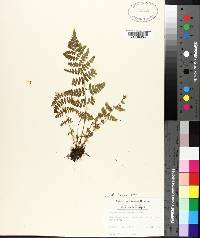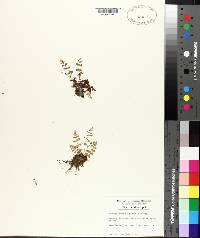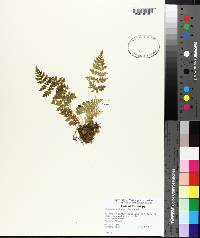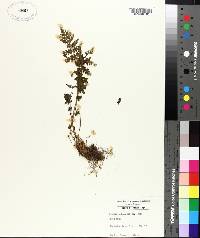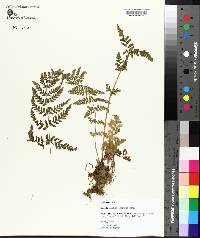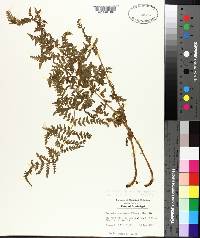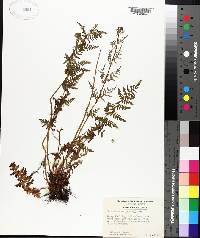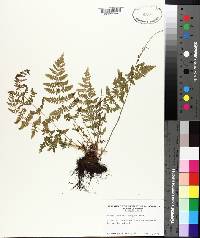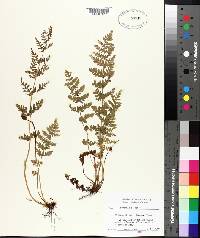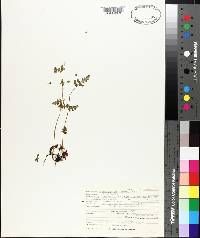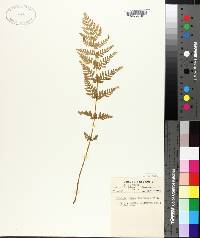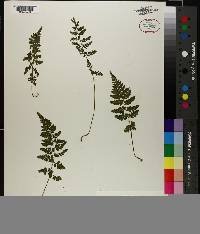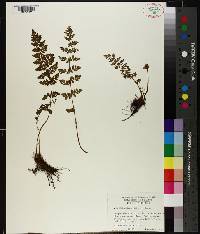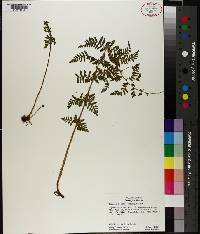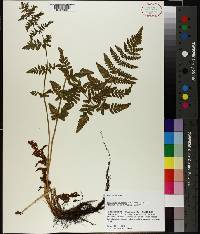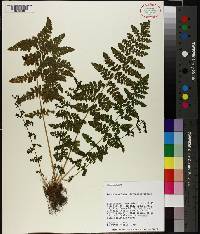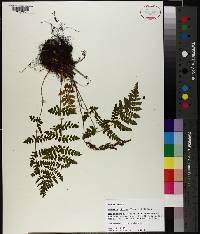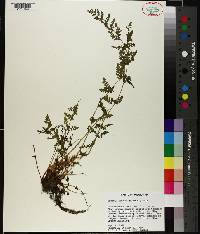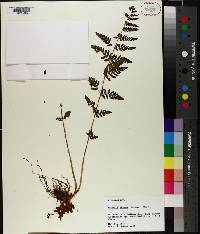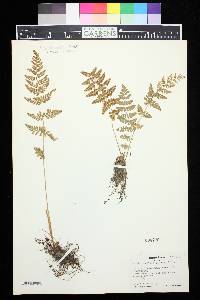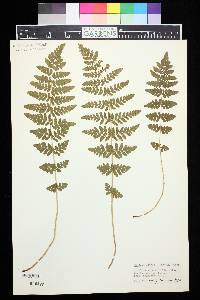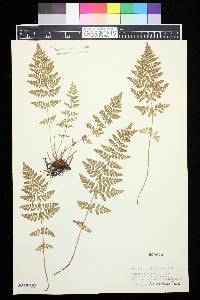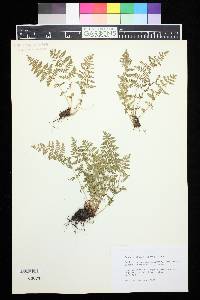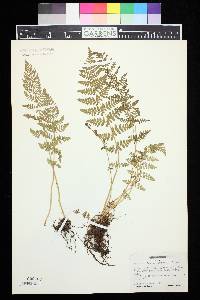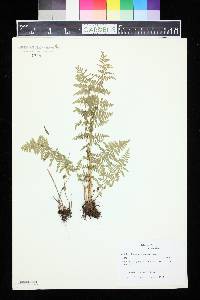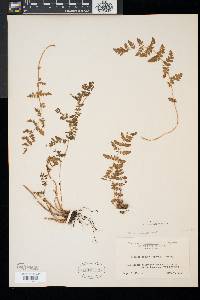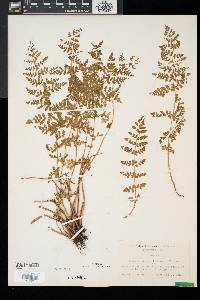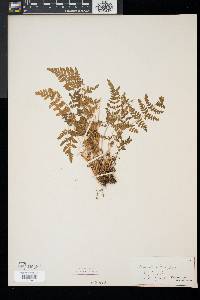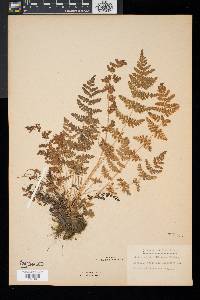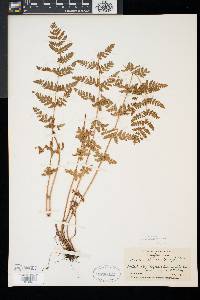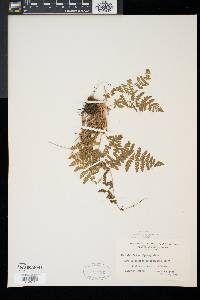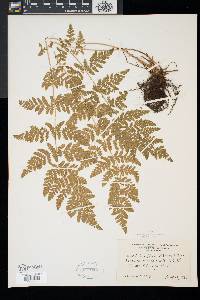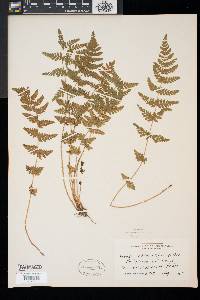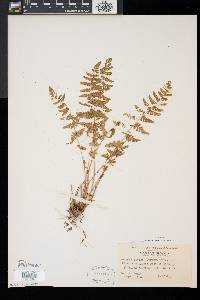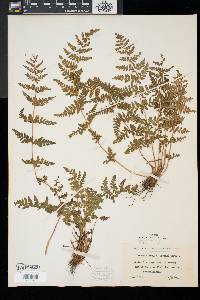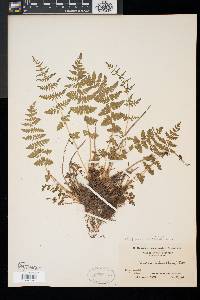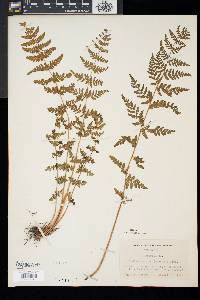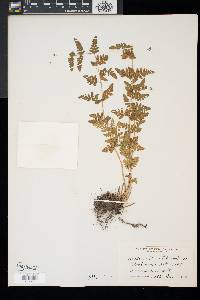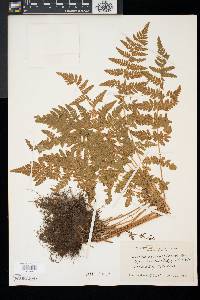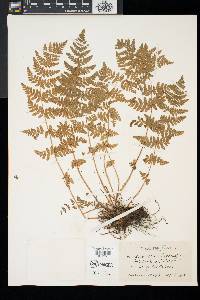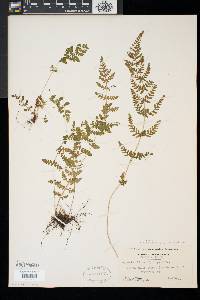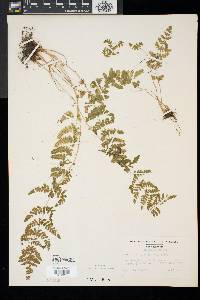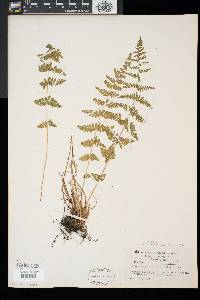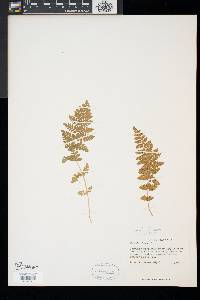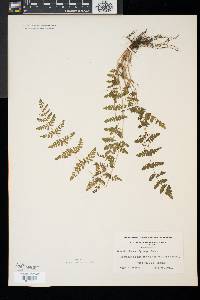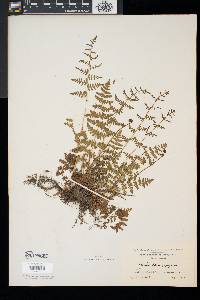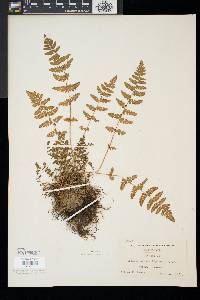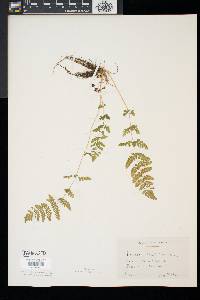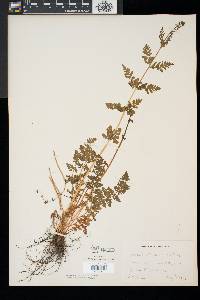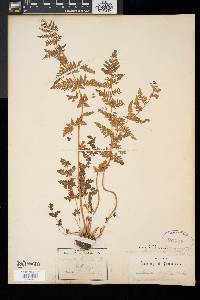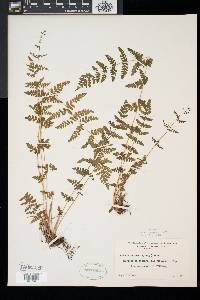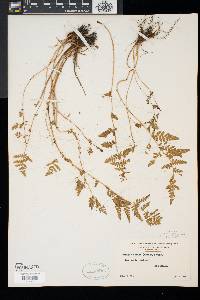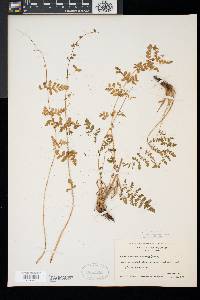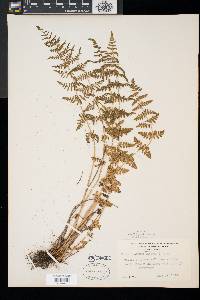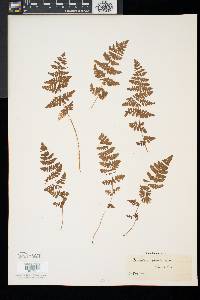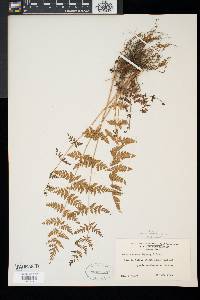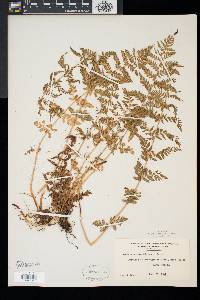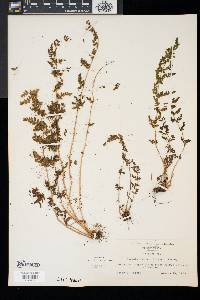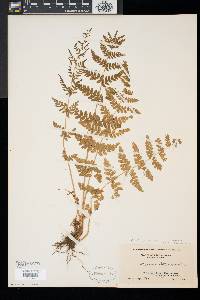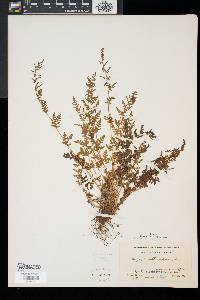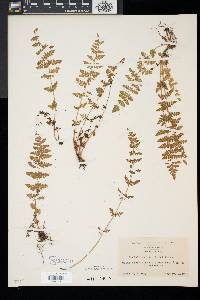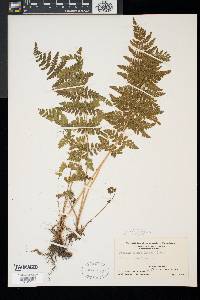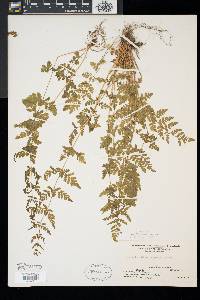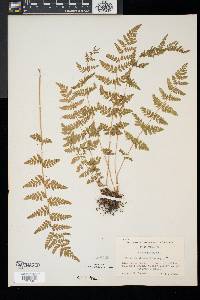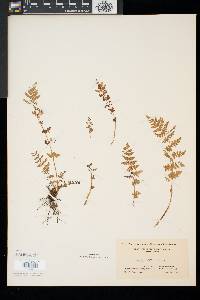
|
|
|
|
Family: Woodsiaceae
Blunt-Lobe Cliff Fern, more...bluntlobe cliff fern
|
Stems compact to creeping, erect to horizontal, with few to many persistent petiole bases of unequal lengths; scales often uniformly brown but at least some bicolored with dark central stripe and pale brown margins, narrowly lanceolate. Leaves 8--60 × 2.5--12 cm. Petiole light brown or straw-colored when mature, occasionally darker at very base, not articulate above base, relatively brittle and easily shattered. Blade lanceolate to ovate, 2-pinnate to 2-pinnate-pinnatifid proximally, moderately glandular, rarely somewhat viscid; many glandular hairs with thick stalks and distinctly bulbous tips; rachis with glandular hairs and scattered, often hairlike scales. Pinnae ovate-deltate to elliptic, longer than wide, abruptly tapered to a rounded or broadly acute apex, occasionally attenuate; largest pinnae with 5--14 pairs of pinnules; abaxial and adaxial surfaces glandular, lacking nonglandular hairs or scales. Pinnules dentate, sometimes deeply lobed; margins nonlustrous, thin, with occasional glands, lacking cilia or translucent projections. Vein tips usually enlarged to form whitish hydathodes visible adaxially. Indusia of relatively broad, nonfilamentous segments, these multiseriate throughout, composed of ± isodiametric cells, entire or glandular along distal edge, concealed by or slightly surpassing mature sporangia. Spores averaging 35--47 µm. Woodsia obtusa comprises two cytotypes that are treated here as subspecies because they show subtle morphologic and ecological distinctions and tend to have different distributions. Tetraploid populations (subsp. obtusa ) are found throughout the eastern flora, commonly occurring on limestone. The diploid (subsp. occidentalis ) is found near the western edge of the species range, usually on sandstone and granitic substrates. Isozyme studies suggest that subsp. obtusa may have been derived from subsp. occidentalis through autopolyploidy (M. D. Windham 1993). The westernmost collections of Woodsia obtusa (all subsp. occidentalis ) come from the Wichita Mountains of Oklahoma and the Edwards Plateau of Texas. Reports of this species from the trans-Pecos region of western Texas are apparently based on misidentifications.
Perennial fern 8 - 60 cm tall Leaves: few, stalked, herbaceous, deciduous, 5 - 25 cm long, 2.5 - 12 cm wide, lance- to egg-shaped in outline, but pinnately divided two times. Both the upper and lower surfaces of the leaves (especially along the veins) have thick, stalked, bulbous-tipped, glandular hairs, and the leaf "midrib" (rachis) also often has scattered hairlike scales. Rhizome: compact to short-creeping, branched (branches 5 - 10 mm diameter), with brown (some pale brown with dark brown center), 2 - 3.5 mm long, lance-shaped scales. Leaf stalks: clustered at rhizome tip, brittle, easilly shattered, long (up to three-fourths length of blade), light brown or straw-colored (occasionally darker at base), sparsely glandular-hairy, and scaly. The bases of the old leaf stalks persist at the crown of the rhizome. Spores: 64 per sac, brownish, 42 - 47 microns in diameter (on average), all of one kind, single-sectioned (monolete), oblong or kidney-shaped, and with crisped edges. The spores give rise to the gametophyte (the sexual phase of the plant), which is small, green, heart-shaped, hairless or often with glands or hairs, and sits above the ground. Similar species: Woodsia obtusa could probably confused with our species of Cystopteris, but those species never have persistent leaf stalk bases, the flap of tissue over the spore clusters (indusium) is never lobed or segmented, and the veins are more prominent and never end in hydathodes before reaching the leaf edge. There is a separate subspecies, W. obtusa ssp. occidentalis, that occurs further southwest of the Chicago Region. It is very similar to the typical subspecies, as described above, except its spores tend to be smaller (35 - 42 microns), the lowest pinnules of the lower pinnae are deeply lobed, the rhizomes can be long-creeping, and the individual rhizome branches are only 3 - 5 mm in diameter. Habitat and ecology: Rare, on rocky cliffs or slopes. Occurence in the Chicago region: native Notes: This species is made up of two different cytotypes that are treated as separate subspecies in the Flora of North America (1993). At this level, all of our material is part of the typical subspecies, W. obtusa ssp. obtusa. The other subspecies, W. obtusa ssp. occidentalis, occurs further southwest of the Chicago Region in the states of Arkansas, Kansas, Missouri, Oklahoma, and Texas. In North America there are two natural groups of species within the genus Woodsia that could be recognized as subgenera. Our species, W. obtusa is part of the group of species that are endemic to the New World and probably have a different genetic lineage than the three species in the other group, which have affinities to species in Eurasia (W. ilvensis , W. glabella, and W. alpina). Hybridization within the groups is common, but rare between the two groups (Windham 1993). Etymology: Woodsia is named for the English botanist Joseph Woods. Obtusa means obtuse, which likely refers to the blunt or rounded tips of the pinnules and their lobes (or teeth). Author: The Field Museum Rhizome-scales few, lance-linear, 2-3.5 נ0.3-0.6 mm, attenuate, sparingly glandular-fimbriate, with a dark central stripe when mature; lvs few, 25-55 cm; petiole stramineous, not articulate, sparingly glandular-hairy and scaly when young; blade lanceolate, 3.5-10 cm wide, slightly narrowed below, bipinnate-pinnatifid, the rachis glandular-hairy and sparingly scaly; pinnae 13-18 pairs, rather remote, subsessile, ovate or lance-ovate, sparsely glandular-hairy on the costae, costules, and veins; pinnules 6-13 pairs, oblong, rounded, deeply pinnatifid with 4-6 pairs of rounded, crenate segments; indusial segments 4-6, several cells wide, glandular-margined, incurved and covering the sporangia when young; 2n=152-156. Shady ledges and loose talus-slopes, mostly in circumneutral soil; Me. to Minn. and e. Nebr., s. to Fla. and Tex. Gleason, Henry A. & Cronquist, Arthur J. 1991. Manual of vascular plants of northeastern United States and adjacent Canada. lxxv + 910 pp. ©The New York Botanical Garden. All rights reserved. Used by permission. |

